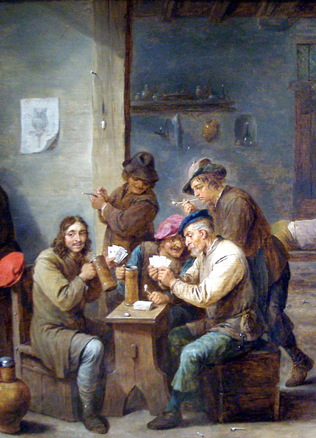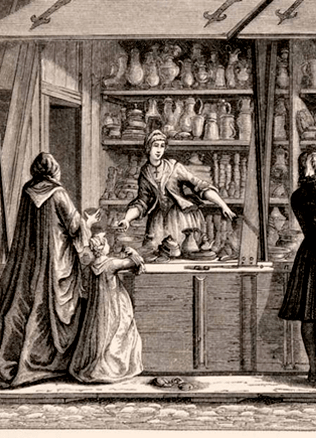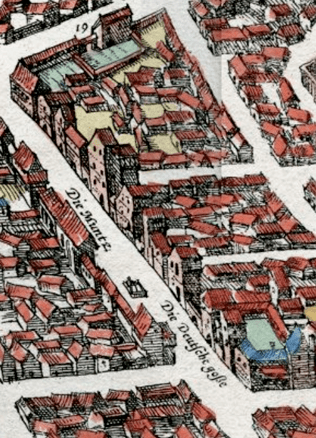Appropriation Economy: Hunting, fishing, beekeeping communities
The forests, rivers and lakes that surrounded settlements and towns have always been an important source of food, fur, skins, wax and honey. Since olden times that has been a secondary source of food for the communities of farmers and cattle breeders. The importance of natural resources, however, increased greatly during the periodically repeated famines caused by crop failure.
The monopoly of the blessings and gist of the forest
Hunting, as an especially favourable pastime often practiced by the nobility, has been recorded in many written sources.
Important political decisions were taken while hunting. By the way, as legend has it, the idea of founding of Vilnius also originated during hunting.
Later great concern about the abundance of resources was expressed at a legal level – about the endangered and desirable species of game. The first Statute of Lithuania (1529) provided for heavy fines imposed on the animals hunted illegally in the forests of the Ruler.
It was during the rule of Jagiełło that a ban on shooting the European bison was introduced, and Sigismund the Old legalised the death sentence for killing the European bison.
Temptation was probably too great. It was calculated that a big bison gave five times, and the red deer three times, more meat than a slaughtered cow. It is interesting to know how important the forest was in everyday life of the ordinary members of a community. The importance of the hunted animals gradually decreased, which is revealed by the investigations into the hillfort of Aukštadvaris. In the layers of the first centuries BC, the bones of wild animals accounted for up to 35.4% of all the discovered bones, in the layer of the first- fourth centuries this figure stood at 21%, in that of the 5th century – at 7%, and in the layer of the 10th–14th centuries the bones of wild animals constituted just 3.1% of a total number of the bones discovered. Hence, on the eve of the historical times cattle breeding was the main source of meat consumed by Aukštadvaris community, hunting played a secondary role. From 0.01 to 13.2% of the bones of hunted animals is found in other ordinary hillforts that functioned in the 14th century. Investigations into the environment of the Grand Dukes showed a different situation. In Trakai Insular Castle, in the territory of the Lower Castle of Vilnius animal bones constituted about one fourth of all the bones discovered. This is related to recreational hunting in which the people of the Duke’s environment engaged, the eating habits of the soldiery, the increased purchasing power of the urban-craftsmen community. These differences in the eating habits of the urban and rural communities are especially evident in the towns of the Grand Duchy of Lithuania in the upper reaches of the Nemunas River. Bones of the animals hunted in Grodno in the 13th–14th centuries account for as much as 57% of a total number of the bones discovered, in Vawkavysk this figure stands at 55%.
Hunters’ target: from the European bison to swans
We have no a single answer to the question what kinds of animals were hunted most often. The bones of the already extinct aurochs and the European bison are not usually distinguished in the reports on the investigations into the bones discovered during archaeological excavations. The bones of wild horses (tarpans) are also identified as those of domestic animals. According to the Statutes of Lithuania, fines were imposed for killing them. Hence, it is supposed that the bones of the eaten domestic horses discovered in hillforts could have belonged to the game. The abundance of the hunted furry animals is unclear because most probably only their skins and fur were brought home. Then it was complicated to preserve the surplus of meat unspoilt. Moreover, different methods of calculating the bones also cause confusion. If the number of bones is taken, large hunted animals dominate – aurochs, elks; if we count the number of hunted individuals, smaller animals, say, wild boars prevail. No interesting tendencies revealing the realities of hunting of that time have been observed. The bones of the aurochs and the European bison clearly dominated in the Lower Castle in Vilnius and Trakai Insular Castle, their bones discovered accounted for 41% and 51%, respectively, of all the bones of the hunted animals. This fact only confirms historical information that hunting of these then endangered animals was the privilege of the Dukes and the people of their surroundings.
Bones of elk, red deer, wild boars, roe-deer, and bears, which still roamed in our geographical area and threatened people, distributed in various proportions are discovered in the cultural layers of the hillforts of the 13th–14th centuries.
Judging from the number of the bones discovered, most often the hunted beavers, foxes, wolves, hare, otter, squirrels, badgers are attributed to the category of furry animals. Beavers were hunted not only for fur but also for meat; badgers were hunted for fat that had healing properties. Sometimes the table was enriched with meat of the shot wild birds. Judging from a small number of bones of the wild birds discovered the supposition can be made that then ducks, geese, partridges, black grouse, wood-grouse and whooper swans were shot.
Gigantic catches
Do You Know?
Fishing enthusiasts most probably would pay a lot for a time journey back to the 13th–14th centuries as then sturgeon that was able to grow up to 5 meters in length and weigh 400 kg swam along the Neris and Nemunas rivers to spawn. Bone plates and other bones of the sturgeon were discovered in the cultural layers of Vilnius Lower Castle and Kernavė. Sizes of the hooks of that time discovered, which reach 6 cm, testify to the size of the catches.
There is no doubt that in the 13th–14th century people engaged in fishing and ate fish. Fish scales is a frequent find in the hillforts, the Lower Castle of Vilnius, the cultural layers of the town of Kernavė. On their basis it was established that the following kinds of fish very well-known today were caught and eaten in those days: pike, perch, chub, bleak, dace, roach, rudd, cod, bream, and silvery bream. Also, most probably scaleless fish was eaten too – catfish and burbot. The bones of the catfish in the town of Grodno of that time accounted for as much as 67.5% of all the fish bones discovered. Rivers are likely to have been much deeper, the sturgeon came along the Neris and Nemunas Rivers to spawn. The sturgeon could grow up to 5 meters in length and weigh 400 kg. Bone plates and other bones of the sturgeon were discovered in the cultural layers of Vilnius Lower Castle and Kernavė. A part of the pike gills discovered in Maišiagala testifies to the fact that large fish used to be caught. According to the gills, it was calculated that the fish head was at least 45 cm long, and the fish itself had to amount to 2 meters in length.
Sizes of the hooks of that time discovered, which reach 6 cm, testify to the size of the catches.
Hooks of different sizes are discovered in the cultural layers of the 13th–14th centuries, both iron and brass, single-fork and double fork hooks. Perfect forms of the hooks surprise us as they do not differ from the hooks made today at all. People fished using fishing rods, the fishing line was woven from horse-hair, the bobs were carved from pine bark, made from a goose feather. A part of an iron fish-spear was discovered in the lower town of Kernavė. In the 13th– 14th century spoon-baits were already used to catch predatory fish, quite a lot of them were discovered in the towns in the upper reaches of the Nemunas – in Vawkavysk, Grodno. Most probably those spoon-baits were used to catch pikes or perch in ice fishing. Nets, fishing-baskets were also used to catch fish, and different enclosures were built. Net knitting and fishing-basket making technologies were known in the Stone Age already. Clay and stone plummets, bobs have been discovered in the cultural layers of the Middle Ages.
Honey was significant as medicine, food supplement, the main constituent part of the alcoholic beverage – mead. Without wax certain technological jewellery processes were impossible, wax was ever more often used to make candles, characters cut on wax plates marked the beginning of writing. Things related to wild bee keeping in hollow trees have been discovered in the lower town of Kernavė: a beekeepers bench with special cut-outs at its ends and a wooden hook used to climb a tree. Honey and wax were important export goods. Two merchants from Kernavė were in debt for several pounds of wax in the 14th century. Because of that their names (Rameizė and Studilė) got into the book of debts of the town of Riga.
Gintautas Vėlius



